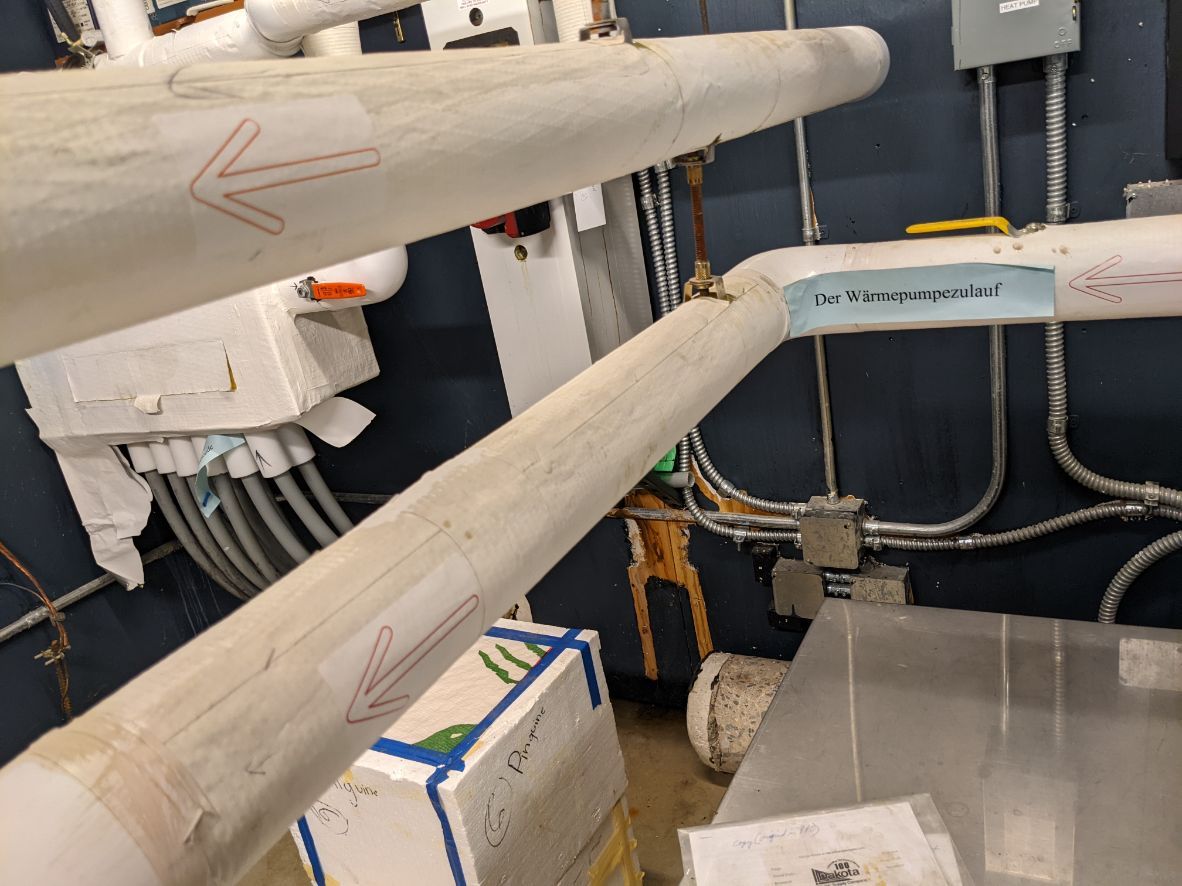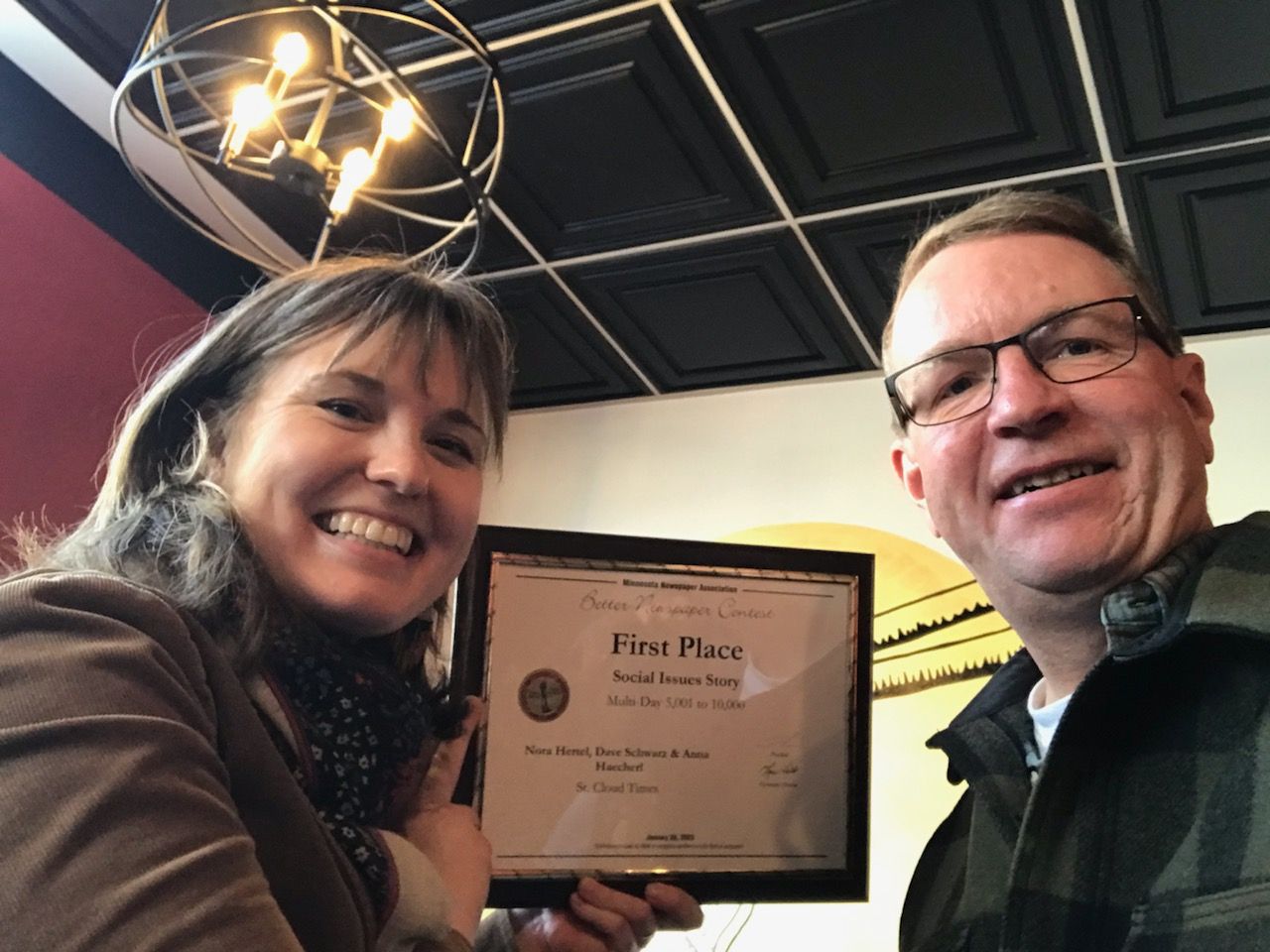What's a heat pump and how does it - what's the word - burn?
A few questions for you and an explainer story
A few questions for you and an explainer story

Exciting updates to old technology
Greetings friends. Nora here, enjoying a bit of a warm spell. I noticed an empty coat rack at an event Tuesday. It was 32 F outside and many of us had left our coats in the car.
I still took the time to replace broken zippers on my warmest coats, and I expect I'll need them soon. And meanwhile my home heat pump is still pumping — drawing warmth from the outside air and depositing it in my house.
I've covered heat pumps a little in the past, in a story about Concordia Language Villages' Biohaus. But I still struggle to explain how they work. The salesman who sold one to my family referenced "basic thermodynamics," in an explanation that remains abstruse to me.
So I've tracked down an explainer story with the hope that it will be as enlightening to you as it was to me.
Before we get to that, I am hoping to gauge what type of stories you are most hungry for. I'm signing contracts with freelancers right now and setting up plans for the next year of journalism. You can help shape that coverage by completing this survey.
Help shape this year's journalism!Thanks for your insights. Enjoy this week's story!
How heat pumps of the 1800s are becoming the technology of the future
Innovative thinking has done away with problems that long dogged the electric devices — and both scientists and environmentalists are excited about the possibilities
By Chris Baraniuk for Knowable Magazine
It was an engineering problem that had bugged Zhibin Yu for years — but now he had the perfect chance to fix it. Stuck at home during the first UK lockdown of the COVID-19 pandemic, the thermal engineer suddenly had all the time he needed to refine the efficiency of heat pumps: electrical devices that, as their name implies, move heat from the outdoors into people’s homes.
The pumps are much more efficient than gas heaters, but standard models that absorb heat from the air are prone to icing up, which greatly reduces their effectiveness.
Yu, who works at the University of Glasgow, UK, pondered the problem for weeks. He read paper after paper. And then he had an idea. Most heat pumps waste some of the heat that they generate — and if he could capture that waste heat and divert it, he realized, that could solve the defrosting issue and boost the pumps’ overall performance. “I suddenly found a solution to recover the heat,” he recalls. “That was really an amazing moment.”
Yu’s idea is one of several recent innovations that aim to make 200-year-old heat pump technology even more efficient than it already is, potentially opening the door for much greater adoption of heat pumps worldwide. To date, only about 10 percent of space heating requirements around the world are met by heat pumps, according to the International Energy Agency (IEA). But due to the current energy crisis and growing pressure to reduce fossil fuel consumption in order to combat climate change, these devices are arguably more crucial than ever.
Since his 2020 lockdown brainstorming, Yu and his colleagues have built a working prototype of a heat pump that stores leftover heat in a small water tank. In a paper published in the summer of 2022, they describe how their design helps the heat pump to use less energy. Plus, by separately rerouting some of this residual warmth to part of the heat pump exposed to cold air, the device can defrost itself when required, without having to pause heat supply to the house.
The idea relies on the very principle by which heat pumps operate: If you can seize heat, you can use it. What makes heat pumps special is the fact that instead of just generating heat, they also capture heat from the environment and move it into your house — eventually transferring that heat to radiators or forced-air heating systems, for instance. This is possible thanks to the refrigerant that flows around inside a heat pump. When the refrigerant encounters heat — even a tiny amount in the air on a cold day — it absorbs that modicum of warmth.

Pipes, tubes and components are labled in English and German in Concordia Language Villages' BioHaus mechanical room to teach campers about the ground-source heat pump and other systems in the building. (Nora Hertel for The Optimist)
A compressor then forces the refrigerant to a higher pressure, which raises its temperature to the point where it can heat your house. It works because an increase of pressure pushes the refrigerant molecules closer together, increasing their motion. The refrigerant later expands again, cooling as it does so, and the cycle repeats. The entire cycle can run in reverse, too, allowing heat pumps to provide cooling when it’s hot in summer.
The magic of a heat pump is that it can move multiple kilowatt-hours of heat for each kWh of electricity it uses. Heat pump efficiencies are generally measured in terms of their coefficient of performance (COP). A COP of 3, for example, means 1 kWh of juice yields 3 kWh of warmth — that’s effectively 300 percent efficiency. The COP you get from your device can vary depending on the weather and other factors.
It’s a powerful concept, but also an old one. The British mathematician, physicist and engineer Lord Kelvin proposed using heat pump systems for space heating way back in 1852. The first heat pump was designed and built a few years later and used industrially to heat brine in order to extract salt from the fluid. In the 1950s, members of the British Parliament discussed heat pumps when coal stocks were running low. And in the years following the 1973-74 oil crisis, heat pumps were touted as an alternative to fossil fuels for heating. “Hope rests with the future heat pump,” one commentator wrote in the 1977 Annual Review of Energy.
Now the world faces yet another reckoning over energy supplies. When Russia, one of the world’s biggest sources of natural gas, invaded Ukraine in February 2022, the price of gas soared — which in turn shoved heat pumps into the spotlight because with few exceptions they run on electricity, not gas. The same month, environmentalist Bill McKibben wrote a widely shared blog post titled “Heat pumps for peace and freedom” in which, referring to the Russian president, he argued that the US could “peacefully punch Putin in the kidneys” by rolling out heat pumps on a massive scale while lowering Americans’ dependence on fossil fuels. Heat pumps can draw power from domestic solar panels, for instance, or a power grid supplied predominantly by renewables.
Running the devices on green electricity can help to fight climate change, too, notes Karen Palmer, an economist and senior fellow at Resources for the Future, an independent research organization in Washington, DC, who coauthored an analysis of policies to enhance energy efficiency in the 2018 Annual Review of Resource Economics. “Moving towards greater use of electricity for energy needs in buildings is going to have to happen, absent a technology breakthrough in something else,” she says.
The IEA estimates that, globally, heat pumps have the potential to reduce carbon dioxide emissions by at least 500 million metric tons in 2030, equivalent to the annual CO2 emissions produced by all the cars in Europe today.
Despite their long history and potential virtues, heat pumps have struggled to become commonplace in some countries. One reason is cost: The devices are substantially more expensive than gas heating units and, because natural gas has remained relatively cheap for decades, homeowners have had little incentive to switch.
There has also long been a perception that heat pumps won’t work as well in cold climates, especially in poorly insulated houses that require a lot of heat. In the UK, for example, where houses tend to be rather drafty, some homeowners have long considered gas boilers a safer bet because they can supply hotter water (around 140 to 160 degrees Fahrenheit), to radiators, which makes it easier to heat up a room. By contrast, heat pumps tend to be most efficient when heating water to around 100 degrees Fahrenheit.
The cold-climate problem is arguably less of an issue than some think, however, given that there are multiple modern air source devices on the market that work well even when outside temperatures drop as low as minus 10 degrees Fahrenheit. Norway, for example, is considered one of the world leaders in heat pump deployment. Palmer has a heat pump in her US home, along with a furnace as backup. “If it gets really cold, we can rely on the furnace,” she says.
Innovations in heat pump design are leading to units that are even more efficient, better suited to houses with low levels of insulation and — potentially — cheaper, too. For example, Yu says his and his colleagues’ novel air source heat pump design could improve the COP by between 3 percent and 10 percent, while costing less than existing heat pump designs with comparable functionality. They are now looking to commercialize the technology.
Yu’s work is innovative, says Rick Greenough, an energy systems engineer now retired from De Montfort University in the UK. “I must admit this is a method I hadn’t actually thought of,” he says.
And there are plenty more ideas afoot. Greenough, for instance, has experimented with storing heat in the ground during warmer months, where it can be exploited by a heat pump when the weather turns cool. His design uses a circulating fluid to transfer excess heat from solar hot-water panels into shallow boreholes in the soil. That raises the temperature of the soil by around 22 degrees Fahrenheit, to a maximum of roughly 66 degrees Fahrenheit, he says. Then, in the winter, a heat pump can draw out some of this stored heat to run more efficiently when the air gets colder. This technology is already on the market, offered by some installers in the UK, notes Greenough.
But most current heat pumps still only generate relatively low output temperatures, so owners of drafty homes may need to take on the added cost of insulation when installing a heat pump. Fortunately, a solution may be emerging: high-temperature heat pumps.
“We said, ‘Hey, why not make a heat pump that can actually one-on-one replace a gas boiler without having to really, really thoroughly insulate your house?’” says Wouter Wolfswinkel, program manager for business development at Swedish energy firm Vattenfall, which manufactures heat pumps. Vattenfall and its Dutch subsidiary Feenstra have teamed up to develop a high-temperature heat pump, expected to debut in 2023.
In their design, they use CO2 as a refrigerant. But because the heat-pump system’s hot, high-pressure operating conditions prevent the gas from condensing or otherwise cooling down very easily, they had to find a way of reducing the refrigerant’s temperature in order for it to be able to absorb enough heat from the air once again when it returns to the start of the heat pump loop. To this end, they added a “buffer” to the system: a water tank where a layer of cooler water rests beneath hotter water above. The heat pump uses the lower layer of cooler water from the tank to adjust the temperature of the refrigerant as required. But it can also send the hotter water at the top of the tank out to radiators, at temperatures up to 185 degrees Fahrenheit.
The device is slightly less efficient than a conventional, lower temperature heat pump, Wolfswinkel acknowledges, offering a COP of around 265 percent versus 300 percent, depending on conditions. But that’s still better than a gas boiler (no more than 95 percent efficient), and as long as electricity prices aren’t significantly higher than gas prices, the high temperature heat pump could still be cheaper to run. Moreover, the higher temperature means that homeowners needn’t upgrade their insulation or upsize radiators right away, Wolfswinkel notes. This could help people make the transition to electrified heating more quickly.
A key test was whether Dutch homeowners would go for it. As part of a pilot trial, Vattenfall and Feenstra installed the heat pump in 20 households of different sizes in the town of Heemskerk, not far from Amsterdam. After a few years of testing, in June 2022 they gave homeowners the option of taking back their old gas boiler, which they had kept in their homes, or of using the high temperature heat pump on a permanent basis. “All of them switched to the heat pump,” says Wolfswinkel.
In some situations, home-by-home installations of heat pumps might be less efficient than building one large system to serve a whole neighborhood. For about a decade, Star Renewable Energy, based in Glasgow, has been building district systems that draw warmth from a nearby river or sea inlet, including a district heating system connected to a Norwegian fjord. A Scandinavian fjord might not be the first thing that comes to mind if you say the word “heat” — but the water deep in the fjord actually holds a fairly steady temperature of 46 degrees Fahrenheit, which heat pumps can exploit.
Via a very long pipe, the district heating system draws in this water and uses it to heat the refrigerant, in this case ammonia. A subsequent, serious increase of pressure for the refrigerant — to 50 atmospheres — raises its temperature to 250 degrees Fahrenheit. The hot refrigerant then passes its heat to water in the district heating loop, raising the temperature of that water to 195 degrees Fahrenheit. The sprawling system provides 85 percent of the hot water needed to heat buildings in the city of Drammen.
“That type of thing is very exciting,” says Greenough.
Not every home will be suitable for a heat pump. And not every budget can accommodate one, either. Yu himself says that the cost of replacing the gas boiler in his own home remains prohibitive. But it’s something he dreams of doing in the future. With ever-improving efficiencies, and rising sales in multiple countries, heat pumps are only getting harder for their detractors to dismiss. “Eventually,” says Yu, “I think everyone will switch to heat pumps.”

This article by Knowable Magazine is published here as part of the global journalism collaboration Covering Climate Now. It was originally published on January 11, 2023. Knowable Magazine is an independent journalistic endeavor from Annual Reviews.
Chris Baraniuk is a freelance science journalist and nature lover who lives in Belfast, Northern Ireland. His work has been published by the BBC, the Guardian, New Scientist, Scientific American and Hakai Magazine, among other publications.
Thanks for being here!
Remember to fill out this quick survey to inform future coverage.
Give us some feedback, please!Kudos to anyone who caught "The Little Mermaid" reference in this newsletter. My child is currently into the Disney songs and movies of the late 1980s and early 1990s.
Stay warm and take care!
♥ Nora Hertel, founder of Project Optimist

The Minnesota Newspaper Association awarded Project Optimist founder Nora Hertel, photographer Dave Schwarz and editor Anna Haecherl (all former colleagues at the St. Cloud Times), with a first place award in the social issues category for a series on climate solutions. Nora and Dave celebrated the win in St. Cloud on Feb. 1, 2023. (Courtesy of Dave Schwarz)
Our mailing address:
P.O. Box 298
St. Michael, Minnesota 55376
Copyright © 2023 The Optimist, All rights reserved.

